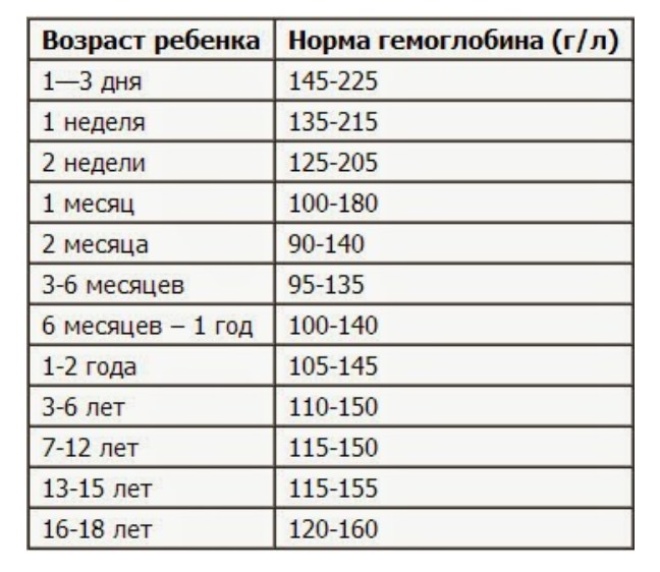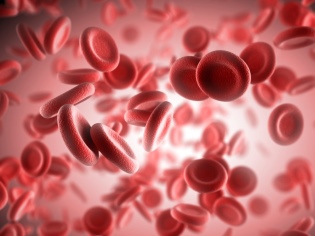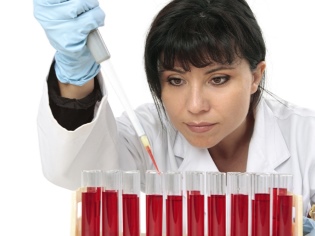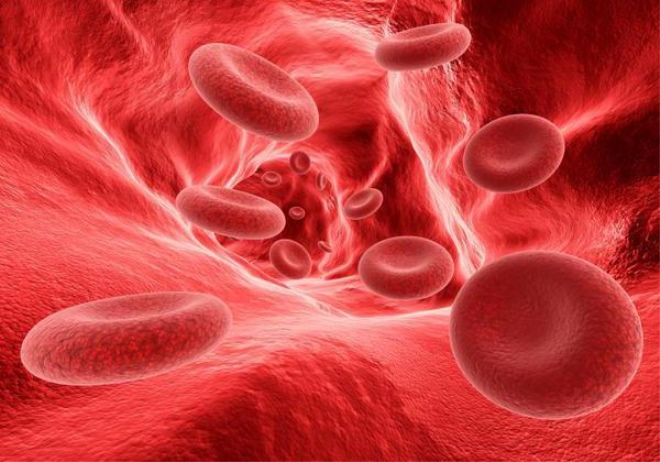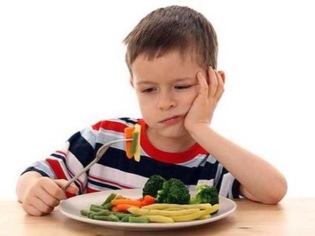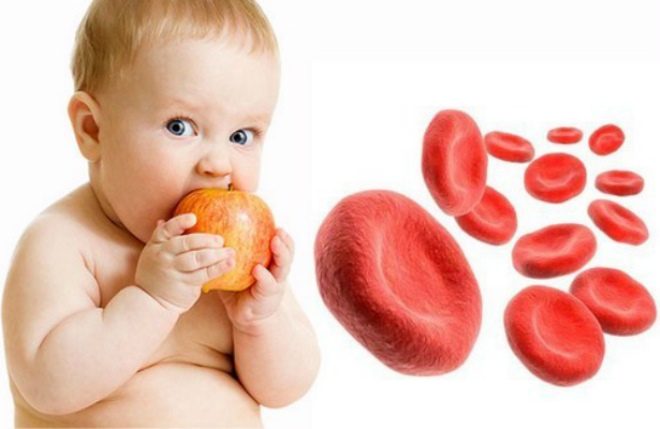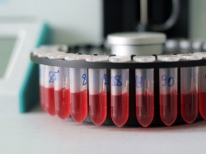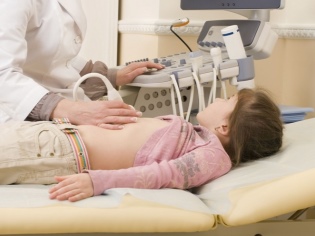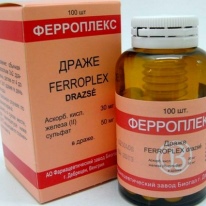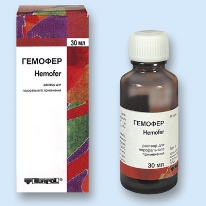Anemia in children
The blood carries a large amount of nutrients that a child’s body needs for growth and development. Red blood cells or erythrocytes are responsible for this process. With a decrease in their number in children, anemia occurs.
What it is?
Anemia is a condition in which there is an insufficient amount of hemoglobin or red blood cells. It is quite common in children's practice. According to world statistics, this disease is registered in every fourth child born.
Red blood cells should normally transfer hemoglobin to the tissues of the whole body. It contains protein structures and iron. Such a special chemical structure allows the red blood cells to carry out the transport function. They deliver oxygen to all cells of the body.
Hemoglobin levels vary significantly with age. During breastfeeding, the baby gets enough iron from the mother's milk. After the cessation of such feedings of hemoglobin reserves, the baby lasts for several months.
If, after withdrawal of breastfeeding, the diet of a child is poor and does not contain sufficient quantities of all nutrients and trace elements, then this quite often leads to the development of anemia.
The average normal level of hemoglobin in a child by the age of seven is about 120 g / liter. A decrease in this indicator below 110 already indicates the presence of an anemic process.
At older ages, hemoglobin and red blood cell levels change. This is due to the development of functional changes in the blood-forming organs.
The peak incidence occurs in age from 3 to 10 years. Every child can get anemia, regardless of age, gender and place of residence. There are many different types of anemia. Different diseases and provoking circumstances lead to the development of each particular form.
The reasons
For the development of a persistent reduction in the total number of red blood cells or hemoglobin, the long-term influence of a factor is necessary. This contributes to the violation of tissue metabolism in the children's body and leads to the development of anemia.
Among the most common reasons:
- Inadequate nutrition. Insufficient intake of products containing iron or folic acid, leads to the development of anemia.
- Low intake of vitamin C or ascorbic acid from food. This biologically active substance is involved in tissue metabolism and helps to maintain a normal number of red blood cells.
- Chronic diseases of the digestive system. Gastritis, enteritis or inflammatory diseases of the gastrointestinal organs are often the causes of metabolic disorders, which leads to anemia.
- Diseases of the blood-forming organs. Pathological conditions that have arisen in the bone marrow or spleen, often lead to disruption of the formation of new generation of red blood cells.
- Prematurity Premature birth leads to the formation of anatomical developmental defects. The organs of the hematopoietic system have developmental disorders, which inevitably lead to the development of anemia in the future.
- Exposure to adverse environmental factors. Contaminated air with a high content of toxic substances leads to disruption of tissue metabolism, and subsequently to persistent anemia.
- Worm invasions. Settling in the intestines, parasites begin to secrete toxic products of their vital activity. This has an adverse effect on the blood and red blood cells.
- Multiple pregnancy. In this case, there is an insufficient intake of all necessary substances for the development of two or more babies at the same time. Quite often, twin babies or twins may have further symptoms and manifestations of anemia. During pregnancy with three babies at once, in almost 75% of cases children have congenital forms of anemic conditions.
- Pathologies and diseases that occurred during pregnancy. Chronic diseases of the female genital organs, infections, as well as exacerbations of various maternal diseases can lead to the development of fetal hypoxia. In this case, in the period of prenatal development in children, anemic manifestations may be observed.
- Frequent infectious diseases. Excessive viral or bacterial load leads to a rapid depletion of immunity. To fight infections you need a huge amount of energy. It is taken from hemoglobin. With frequent infectious diseases, a decrease in the amount of this substance occurs, which leads to the development of anemia.
- Congenital forms. Arise due to underdevelopment of blood-forming organs. This pathology usually develops in the first trimester of pregnancy. After childbirth, a reduced level of hemoglobin or red blood cells is recorded in the baby.
- Oncological diseases. Even with the localization of tumors in different organs, anemia can develop. Tumor growth also requires an increased amount of nutrients, as well as for normal healthy cells. Increased consumption of nutrients and hemoglobin leads to the development of persistent anemia.
- Bleeding or trauma effects. Large blood loss causes a general decrease in hemoglobin and red blood cells. Such forms are called post-hemorrhagic. They can also occur due to tuberculosis or the disintegration of a large tumor.
- Hereditary. Have a pronounced genetic predisposition. Thus, in case of Fanconi anemia, the formation of new red blood cells is impaired due to the insufficiently good bone marrow work. Such forms are rarely found in children.
- Long reception of various medicines. Cytotoxic drugs, sulfanilamide, benzene compounds, as well as some antibacterial drugs can cause anemia.
- Incorrectly provided surgical benefits during childbirth. Untimely separation of the placenta, poor umbilical cord ligation, or other errors during labor can cause anemia to develop further in the child.
- Rheumatological diseases. Systemic lupus erythematosus or rheumatoid arthritis are often causes that lead to the appearance of anemic signs in babies. The first symptoms are recorded already in 2 years.
- Autoimmune diseases. They lead to a decrease in the total hemoglobin content of the red blood cells, which leads to the development of anemia.
Classification by disease mechanism
Currently, there are many different anemic conditions. Modern classifications allow us to distribute pathology that is similar for reasons of development to certain groups. This allows doctors to accurately determine the cause of the disease and verify the diagnosis.
All anemic conditions can be divided into several groups:
- Hemolytic. Characterized by increased destruction of red blood cells. Often occur as hereditary diseases or as a result of long-term medication.
- Post-hemorrhagic. Occur after massive bleeding, leading to a pronounced loss of circulating blood volume.Can meet at any age. Characterized by a decrease in the total number of red blood cells and hemoglobin.
- Iron deficiency. Characterized by low levels of iron. Such deficient forms of anemia occur predominantly with malnutrition, as well as chronic bowel disease. It may also be the only manifestation of a growing tumor. Can be hyper - and hypochromic.
- Folic acid deficiency. Occur with a reduced content of folic acid. The most often begin to develop in the period of intrauterine development. May occur in babies and after birth as a result of insufficient intake of folic acid from the outside, as well as in chronic diseases of the stomach and intestines.
- B12-deficient. Characterized by a low content in the body of vitamin B12. Developed with diseases of the gastrointestinal tract, as well as during helminthic invasions. Often combined with folic acid deficiency anemia.
- Hereditary. As a result of Minkowski-Chauffard disease, rapid and pathological destruction of altered red blood cells occurs. Hereditary forms of the disease are quite rare. Every three out of ten thousand babies born have this disease. The disease manifests itself already at 1 year of life of the child, having a genetic predisposition.
- Hypoplastic or aplastic. Arise in connection with impaired bone marrow. As a result of this state, new red blood cells are practically not formed. The accelerated destruction of red blood cells only aggravates the anemic condition.
Classification by severity
During the development of anemia, hemoglobin levels decrease. The lower it is, the more unfavorable anemic symptoms may develop. This classification allows you to set the severity of the disease, taking into account the quantitative determination of the level of hemoglobin in the blood.
According to the level of reduction of this indicator, all anemias are divided into:
- Lungs. Hemoglobin level is more than 90 g / liter. The severity of clinical symptoms is negligible. Often, this condition is detected by chance during screening or when taking a general blood test due to other diseases.
- Medium heavy. The hemoglobin level ranges from 70 to 90 g / liter. Symptoms are more pronounced. Observed strong changes in tissue respiration. The condition requires mandatory treatment and prescription of drugs for course administration.
- Heavy. Occur with a decrease in hemoglobin below 70 g / liter. Accompanied by a strong violation of the general condition. They require the immediate determination of the cause of the disease and the immediate prescription of drugs.
Symptoms
The first signs of an anemic condition can appear even in young children. Often they are non-specific. This makes it difficult to establish the diagnosis in its early stages. Typically, the symptoms of anemia begin to appear quite clearly with a decrease in hemoglobin below 70-80 g / liter.
The most common manifestations of anemia are:
- Change in general condition. Toddlers are becoming more lethargic. Even after usual occupations they get tired faster. In adolescents, there is a rapid development of fatigue even after 2-3 lessons in school. The habitual daily load can lead to increased general weakness.
- Pale skin. In some cases, the skin becomes even somewhat earthy. With a marked decrease in hemoglobin level, you can notice blueing of the lips and blanching of the visible mucous membranes.
- Quick change of mood. Toddlers more often capricious. Even the calmest child can become capricious and very whiny.
- Increased anxiety. The baby becomes more nervous. Some babies have disturbed sleep.
- Persistent increase in body temperature to subfebrile numbers. It usually increases to 37 degrees and lasts for a long time. In this case, the baby has no runny nose, cough or any other catarrhal symptoms.
- Changing food habits. Violations of the processes of tissue metabolism lead to the development of abnormal or uncharacteristic for the child's gustatory desires. For example, some kids start to gnaw chalk. A child may have a reduced appetite, and their taste preferences may change.
- Severe chilliness. Usually, babies complain that they have a lot of hands and feet.
- Blood pressure instability. Some babies often have hypotension.
- Rapid pulse. The lower the hemoglobin level in the child's body than the higher tachycardia. With an excessively low amount of hemoglobin, a decrease in oxygen in the tissues is observed. This leads to the development of tissue hypoxia and starvation of the heart muscle cells.
- Weak immunity. Insufficient nutrients as a result of lower hemoglobin levels leads to poor functioning of the cells of the immune system. With such a long state, secondary immunodeficiencies develop.
- Disorders of the digestive system. Babies may develop diarrhea or constipation, as well as a feeling of difficulty swallowing while eating.
- Secondary non-specific signs: excessive hair loss, frequent tooth decay, severe dryness of the skin, formation of small ulcers near the lips, increased fragility of the nails.
Features of iron deficiency anemia in children
This type of anemic condition is most common in pediatric practice. It occurs as a result of insufficient intake of iron from food, and in some cases, with the active destruction of the red blood cells present in the body. This leads to various diseases of the gastrointestinal tract.
Iron-deficiency anemia prevalent throughout the world. According to European studies, every second child with anemic syndrome, an iron deficiency is recorded. Normally, the content of this trace element in the body is about four grams. This amount is quite enough to perform basic functions.
Almost 80% of iron is contained in hemoglobin. There, it is in an active state, since the red blood cells constantly perform a transport function to transport oxygen and nutrients throughout the body.
There is also a reserve stock. It is located in the liver and macrophages. This iron is in an inactive state. The organism makes such a strategic reserve in case of severe blood loss or possible injury, which will be accompanied by severe bleeding. The proportion of reserve iron is 20%.
Iron enters the body with food. For the correct functioning of the blood-forming organs, usually 2 grams of this substance are sufficient. However, if the child has chronic diseases of the stomach or intestines, then the amount of incoming iron should be greater. This is also facilitated by the concomitant rapid loss of red blood cells as a result of erosions or ulcers that occur in diseases of the gastrointestinal tract.
For the treatment of iron deficiency anemia in children requires the appointment of a special diet. It is required to observe such nutrition for a long time until the stabilization of the state is complete.
Usually, it may take 6 months or more to normalize the level of iron in the body and persistent fixation of the result.
In severe cases of the disease requires the appointment of special iron preparations. Such drugs help to compensate for the iron deficiency in the children's body and lead to the normalization of the condition. They are appointed, as a rule, for a long reception. In the course of treatment, mandatory monitoring of hemoglobin in the blood is carried out.
Diagnostics
In order to establish the presence of anemia, first of all, a routine blood test should be performed. Reduced hemoglobin or red blood cells below the age norm indicates the presence of signs of anemic syndrome.
To determine the type of anemia, a color index is often also evaluated. Normally, it should be 0.85. If this value is exceeded, they are referred to as hyperchromic anemias, and when decreasing - hypochromic. Such a simple diagnosis helps doctors to establish the correct diagnosis and to identify the cause, which contributed to the development of anemic condition.
When iron deficiency anemia is resorted to the determination of the total amount of iron in the body, as well as transferrin indicators. It shows how well the erythrocyte is filled with iron from the inside. The level of ferritin helps to clarify the nature and cause of iron deficiency anemia.
To determine hypoplastic anemia, bilirubin level determination will be required. An analysis of the content of vitamin B12 and folic acid in the body will help in clarifying the diagnoses of anemic conditions that occur when they are deficient.
In difficult diagnostic cases, the pediatrician will recommend contacting a gastroenterologist, cardiologist, rheumatologist, nephrologist. These specialists will help clarify the presence of chronic diseases of various internal organs that could cause the development of anemic syndrome in a child.
Ultrasound examination of the liver and spleen allows to clarify the presence of pathology in these organs responsible for blood formation. For aplastic anemia, a bone marrow biopsy may be required. Only with such a study can we determine, as a result, an anemic syndrome has developed.
Complications
In case of late diagnosis, an anemic condition can be very dangerous. Prolonged oxygen starvation of body tissues leads to the development of persistent abnormalities in the work of internal organs. The longer the hypoxia develops, the greater the likelihood of complications.
Most often, anemic syndrome leads to:
- The development of immunodeficiency. Insufficient active work of the immune system contributes to the light susceptibility of the baby to various infectious diseases. Even the common cold can last long enough and require the appointment of high doses of drugs.
- The development of cardiovascular pathologies. Anemic condition contributes to the development of oxygen starvation. This process is especially dangerous for the heart muscle and the brain. With prolonged hypoxia, which developed as a result of anemia, myocarditis may occur. This condition is manifested in violation of the contractile function of the heart and leads to the appearance of cardiac rhythm disturbances.
- The appearance of persistent disorders of the nervous system. Severe dizziness, a feeling of pulsation in the temples, diffuse severe headache - all these signs may be manifestations of complications of the anemic state.
- The development of pathological conditions of the gastrointestinal organs. Long-term violations of the stool can lead to the development of dysbiosis and irritable bowel syndrome in babies.
- Violation of memory and the difficulty of memorizing new material. The most dangerous manifestation of the disease at school age. The inability to prolonged concentration and reduced memory contribute to a decrease in the child's performance at school.
- Asthenization. With severe disease in children, there is the emergence of severe general weakness. With prolonged development of the disease, there is even some hypotrophy and even muscle atrophy. The child looks overly tired and exhausted.
Treatment
According to the clinical guidelines, all forms of anemic conditions should be treated from the moment the hemoglobin level is determined to be below the age norm.
Therapy for anemia begins with establishing the cause that led to its development. It makes no sense to replenish lost hemoglobin, if the body is its regular loss.
In order to establish the cause, additional examinations and analyzes are required. With their help, one can qualitatively carry out differential diagnostics and prescribe the necessary therapy.
Treatment of anemia is complex. It includes not only the prescription of drugs, but also recommendations on the normalization of the day regimen and nutrition. Medications are prescribed only in case of a marked decrease in the level of hemoglobin in the body. In the mild form of the disease, treatment begins with the appointment of a special diet.
The basic principles of the treatment of anemia:
- A full diet, enriched with all the necessary vitamins and trace elements. Special emphasis in the children's diet is on foods high in iron, vitamin B12, folic acid, copper, as well as all the necessary trace elements involved in blood formation.
- Prescription drugs. They are discharged by the attending physician. Assigned to the course reception. After 1-3 months from the start of medication, regular monitoring of the level of hemoglobin and red blood cells is carried out. Such monitoring allows to evaluate the effectiveness of selected drugs.
- Normalization of the daily routine. A full-fledged sleep, rest in the daytime, as well as a decrease in intense physical and psychoemotional stresses are required for the child to improve the therapy process.
- Surgery. It is used when a tumor or pathological processes in the spleen becomes the culprit of the disease. Splenectomy in most cases helps to improve the course of the disease in this form of the disease.
- Treatment of secondary chronic diseasesthat could cause anemia. Without eliminating the primary focus of inflammation, it is impossible to cope with the normalization of hemoglobin levels. If there is a bleeding sore or erosion in some organ, then even despite the regular intake of drugs, it is not possible to achieve complete stabilization of well-being. Elimination of all the causes that caused the anemic syndrome is first required.
Iron preparations
In the treatment of iron deficiency anemia, the appointment of drug treatment is required in the vast majority of cases. Often, compliance with only one diet is insufficient.
If hemoglobin does not return to normal in the course of three months due to regular consumption of foods rich in iron, you should show your baby to a pediatrician. To fully stabilize the state, the doctor will prescribe iron supplements.
For the treatment of iron deficiency can be used several types of drugs. They may contain bivalent and trivalent iron in various chemical combinations. The effectiveness of these funds is different. Dosages are selected individually, taking into account the severity of the condition, the initial well-being of the child, as well as his age.
For babies up to three years, the physiological need of iron at 3 mg / kg per day is used to calculate the dose. For older kids - 50 mg / kg. In adolescence, 100 mg / kg is already required. This calculation formula is used for preparations containing ferrous iron. If ferric iron is used, then the dosage is on average 4 mg / kg.
Monitoring the effectiveness of selected drugs produced by the indicators of the general blood test. The effect of treatment does not come quickly. Usually, it takes at least 2-3 months to normalize hemoglobin levels. First, young blood cells appear in the blood - reticulocytes. Subsequently, an increase in hemoglobin and red blood cells is observed.
Most often, iron supplements are prescribed in the form of tablets or sweet syrups. However, the use of these dosage forms may not always be acceptable. If a child has ulcerative processes in the stomach or intestines, then he is prescribed iron-containing preparations in the form of injections.These funds have excellent absorbability and well reach the blood-forming organs.
Ferrum leks, Gemofer, Konferon, Ferropleks and many others are used most often to normalize the level of iron. The selection of the drug is chosen by the attending physician taking into account the chronic diseases of the child. When taking iron-containing drugs should be remembered that they stain feces in black.
Nutrition
The organization of the children's menu for anemia should be given due attention. Only good nutrition will help to normalize the level of hemoglobin and quickly bring the children's body back to normal.
In the diet of the baby should definitely include foods with a maximum iron content. These include: beef, veal, rabbit, chicken and poultry tibia, offal (especially liver). In the diet of a child suffering from anemia, such foods should occupy more than 50%. Each meal should include at least one iron-containing product.
If the baby is still too small and is breastfed, it is better to give preference to special artificial mixtures, which contain in their composition a high content of iron. They are also perfectly balanced in their nutritional components and contain an additional amount of trace elements necessary for optimal blood formation.
For sufficient intake of folic acid, you should add to the diet of the baby a variety of vegetables and herbs. All green foods contain a large amount of folate. These substances are necessary for the implementation of good blood, especially children with folic deficiency anemia.
Babies of infancy can add a variety of juices and purees made from green apples and pears. Such products remarkably diversify the children's table and will also be able to normalize the level of folic acid in the body.
In order to compensate for the reduced level of vitamin B12, one should not forget about the inclusion in the child's diet of cereals made from various cereals. Buckwheat or barley porridge will be an excellent choice when composing a menu for a kid with B12 deficiency anemia. To achieve the best effect of cereals is better to alternate.
Eating a baby with anemia should be balanced and varied. For active blood formation requires a regular flow of all types of animal and plant products. Fresh fruits and vegetables, high-quality meat and fish products, as well as poultry and cereals contribute to the qualitative formation of new red blood cells.
Prevention
Compliance with preventive measures will help reduce the possible risk of developing anemic conditions. Every pediatrician should suspect anemia during regular check-ups and examinations of the child. Even the most simple laboratory tests help to identify anemic signs.
To prevent anemia, use the following recommendations:
- Regularly visit the children's doctor. Conducting a general blood test as a screening will allow time to identify the first manifestations of anemic syndrome.
- Try to carefully plan the diet of the baby. Be sure to include in it all kinds of animal and plant products allowed by age. Meat, poultry and fish must be present in the diet of the baby every day.
- If you have a hereditary predisposition to anemia, consult with a hematologist. He will be able to give accurate recommendations and prescribe appropriate treatment.
- With multiple pregnancies, rest more often. and be more attentive to your diet. Prefer iron-containing products, as well as fresh vegetables and greens. Such nutrition will contribute to the correct laying of blood-forming organs in future babies and will not contribute to the development of anemia.
- Develop a child's love for a healthy lifestyle. Try to keep your baby regularly in the fresh air.
- Use iron supplements. in prophylactic dosages for premature babies. They will help prevent the development of anemia in the future. Such preventive courses are prescribed by a pediatrician.
Normalization of hemoglobin levels leads to improved well-being. After achieving a stable therapeutic result, babies begin to feel much better, become more active and mobile. Regular monitoring of hemoglobin levels is necessary at any age to prevent anemia.
More information about anemia in children can be seen in the next video.





